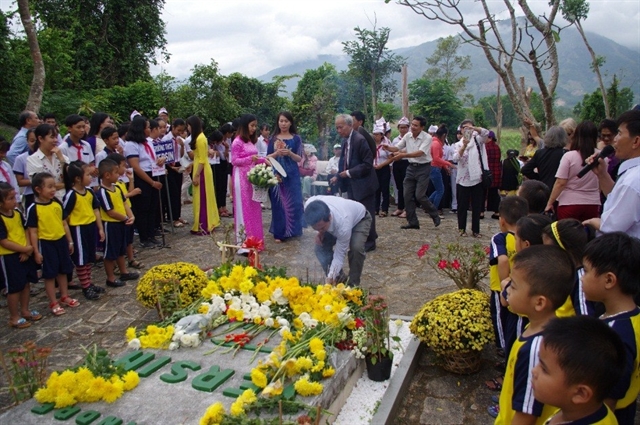A visit to the site enables tourists to learn about the life of the great scientist and doctor who spent most of his life and work dedicated to the country.

STAIRWAY: The entrance to the Dr Alexandre Yersin's grave site. It is located about 20km from Nha Trang City. VNA/VNS Photo Phan Sáu
The grave of acclaimed Swiss-French Dr Alexandre Yersin (1863-1943) has become a spiritual tourist landmark in the central province of Khánh Hòa for those wishing to pay their respects to his extraordinary contributions to medicine and the people of Việt Nam.
Yersin is remembered as the co-discoverer of the bacillus responsible for the bubonic plague, which was later named in his honour: Yersinia pestis.
A visit to the site enables tourists to learn about the life of the great scientist and doctor who spent most of his life and work dedicated to the country.
While driving along National Highway 1A through Suối Cát Commune, visitors will see a signboard pointing out the site. About 1km down a trail, the doctor's grave nests under the shade of a few trees on a small hill accessed through arched stone steps. It is located near Suối Dầu Ranch in Suối Cát Commune, Cam Lâm District, about 20km from the centre of Nha Trang City to the southwest.
Nguyễn Thị Ngọc Hoa, a resident of Cam Lâm, says that many families visit the site on holidays, not only to burn incense and pay tribute to the doctor but also to teach their children about his life and career.
Luxuriant tall trees grow on both sides of the path leading to Dr Yersin’s grave. Among them are old flamboyant and resin trees with name boards in English and Vietnamese.

RESTING PLACE: The doctor's grave is nested on the top of a hill in Suối Cát Commune. VNA/VNS Photo Phan Sáu
There is a tranquil atmosphere. Passing through the large gate, visitors can climb a slope lined with stone and cement embankments. Dr Yersin’s grave is at the top of the hill. Next to his grave is a stele with an inscription of his biography in Vietnamese and French.
“Alexandre John Emile Yersin was born on September 22, 1863 in Lavaux Village (Lavaux County), Switzerland. His ancestors were French immigrating to Switzerland in 1685,” it says.
“In 1889, Alexandre Yersin had his French nationality restored. He passed away in Nha Trang on March 1, 1943. He was honoured with the Medal of ‘Ordre national de la Légion d’honneur’ and ‘’Grand Croix du Dragon d’Annam.'”
His tombstone epitaph describes Yersin as a "Benefactor and humanist, venerated by the Vietnamese people."
Yersin was a member of the Academy of Sciences, Academy of Medicine, Academy of Sciences of the Colonies, and the French Astronomical Society.

RESPECTED: A potrait of Dr Alexandre Yersin (1863-1943). File Photo
He discovered a Diphtheria toxin in 1888 and first surveyed Lâm Viên plateau in 1893, which contributed to the establishment of the resort city of Đà Lạt.
The doctor discovered the bacillus causing bubonic plague in Hong Kong in 1894 and prepared a plague anti-serum. He was the founder and first Director of the Pasteur Institute Nha Trang (1895), and also credited for introducing rubber trees to Việt Nam in 1897 and quinoa plants in 1917.
Surrounding the grave are many different trees and plants, including quinine the tree from which he found medicinal drug to treat malaria.
On March 1, 1943, in the last moments of the great doctor’s life, he intimately looked at the people around his bed, bid his final goodbye and closed his eyes.
Hearing that Dr Yersin, fondly called “Uncle Five” by locals, was taking his last breath, many Nha Trang residents wearing mourning scarves came to visit him, full of infinite grief, including many who had immediately returned from fishing trips at sea.
Dr Yersin’s funeral was held on March 3, 1943. Many people, from young to old, came to mourn and lined up to bid him farewell in his final resting place. In his will, the doctor requested his funeral to be organised modestly without any eulogy.
He asked to be buried face down, arms outstretched so that he could embrace the land that was not his birthplace, but which he deeply loved.

MARK OF RESPECT: A visit to Dr Yersin's grave will enable tourists to pay tribute and learn about the life of a great scientist and doctor who spent most of his life dedicated to Việt Nam. Photo danviet.vn
Dr A. Yersin's Grave Site, recognised as a Vietnamese national historical heritage in 1990, is a must-visit destination for visitors to Khánh Hòa Province who wishes to pay tribute to the great doctor who made so many significant contributions to not just Việt Nam but the whole of mankind. VNS